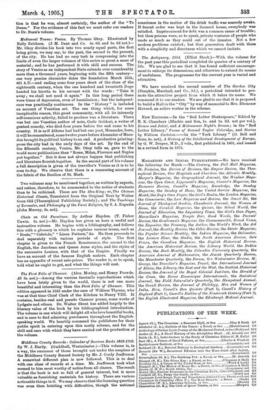Mediaeval Towns : Venice. By Thomas Okey. Illustrated by Nelly
Erichsen. (J. M. Dent and Co. 48. 6d. and 55. 6d net.)— Mr. Okey divides his book into two nearly equal parts, the first being given, we may say, to the past, the second to the present, of the city. He has had no easy task in compressing into the limits of even the larger volumes of this series so great a mass of material; and he has performed it with skill and success. The story of Venice as an independent State extends over considerably more than a thousand years, beginning with the fifth century— one very precise chronicler dates the foundation March 25th, 421 A.D.—and ending some four years short of the close of the eighteenth century, when the one hundred and twentieth Doge handed his biretta to his servant with the words : "Take it away ; we shall not need it again." In this long period there were times of depression, even of humiliation ; but the independ- ence was practically continuous. In the " History " is included an account of Venetian art. The one thing which, for some inexplicable reason, this great community, with all its intensely self-conscious activity, failed to produce was a literature. There was but one Venetian author of note, Carlo Goldoni, a writer of genteel comedy, who died four years before the end came to his country. It is as if Athens had had but one poet, Hollander, born, it will be remembered, some twelve years before Alexander of Mace- don brought its political history to an end. A productive printing. press the city had in the early days of the art. By the end of the fifteenth century, Venice, Mr. Okey tells us, gave to the world more publications than "Rome, Milan, Florence and Naples put together." But it does not always happen that publishing and literature flourish together. In the second part of his volume a full description is given of the traveller's Venice as it is to be seen to-day. We observe that there is a reassuring account of the fabric of the Basilica of St. Mark.










































 Previous page
Previous page